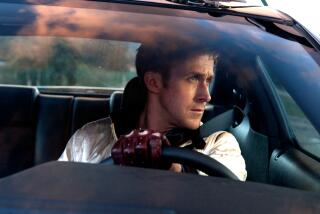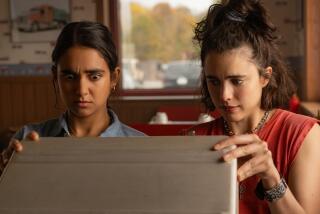Critic’s Notebook: ‘Drive’ tours an L.A. that isn’t on postcards
The director Nicolas Winding Refn is Danish, has spent the bulk of his career far from Hollywood and doesn’t have a driver’s license, all of which would seem to make him an unlikely candidate to create a movie that successfully captures the slippery urban and architectural character of Los Angeles.
And yet “Drive,” Refn’s eighth feature, is one of the most perceptive recent attempts to understand the peculiarly standoffish personality of L.A.’s built environment. If you can get through the gruesome violence of the film’s second half, you’ll discover the portrait of an unforgiving city that ambitiously mixes influences as diverse as directors Michael Mann, Quentin Tarantino and Walter Hill and writers Nathanael West, J.G. Ballard and Mike Davis.
Just don’t expect glamour shots of Walt Disney Concert Hall, Griffith Observatory and other postcard landmarks; what you see through the windshield of the cars in “Drive” is largely the drab, closed-off and forgettable cityscape of the Southern California commercial strip.
Whenever any building in the movie shimmers or gleams, it is because it is being seen from an impossible distance, shot from a helicopter gliding over Bunker Hill at night or hovering Oz-like way off on the horizon. Otherwise, the characters in “Drive” spend most of their time in elevators, cheap apartments, greasy spoons and parking garages, grimly navigating a downmarket version of the anonymous urban interiors that the architect Rem Koolhaas once dubbed “junkspace.”
“Drive” is far from perfect; in its outsized debt to Hollywood history it routinely edges into cliché, although mostly of the knowing, tongue-in-cheek kind. (The bad guys wear track suits and gold chains.) But there is a method to the movie’s architectural banality. The hero — or antihero — of “Drive,” a stunt driver and petty criminal played by Ryan Gosling, is unnamed; like Sergio Leone, Refn keeps his protagonist strictly anonymous.
You could say the same thing about the way Refn — along with his cinematographer, Newton Thomas Sigel, and his production designer, Beth Mickle — portray Los Angeles. There are no pedigreed buildings by big-name architects here; there are storage facilities and strip malls and auto-body shops.
Though the movie is set in the present day, it has a heavy ‘80s vibe that is carefully calibrated from start to finish and is underscored not just by the cars, the clothes, the music and the opening credits (the titles are in pink) but also by the architecture. The city that flashes by, as the characters drive down endless boulevards in the Valley and near downtown, is all cheap stucco and mirrored glass; it has been carefully edited to leave out, for the most part, any obviously new buildings.
In those excisions “Drive” shares something with “(500) Days of Summer,” the 2009 movie that celebrated its characters’ love of L.A.’s prewar downtown architecture by deliberately avoiding any structures built after about 1960. But while “(500) Days” was upbeat in its embrace of all things anachronistic, “Drive” is going for a very different tone, with characters who are not mildly eccentric and upwardly mobile but operatically troubled and struggling to pay the bills.
In a city where apartment living still, according to Hollywood, signals failure or worse, Gosling’s driver and the woman he falls for, a waitress and young mother named Irene (Carey Mulligan), live in charmless rentals overlooking MacArthur Park. They shop in a cramped local grocery whose aisles would be narrow by Manhattan standards, and where even the paper bags are undersized.
The driver also spends a lot of time around the outer edges of downtown. Whether he’s in his apartment or his car, the skyline seems always to be hovering way somewhere over his shoulder. That produces one of the movie’s subtlest visual jokes: He’s on the periphery of a downtown that often seems less than fully central in the multipolar geography of Los Angeles. He’s grown comfortable on the outskirts of the outskirts, which maybe makes him a true Angeleno.
There is plenty of early Tarantino in “Drive’s” portrayal of the Los Angeles underbelly. But Gosling’s driver and the other major characters, including Albert Brooks’ Bernie Rose, seem most clearly of all to be descendants of the depressives in West’s 1939 novel “The Day of the Locust,” the movie version of which, directed by John Schlesinger and released in 1975, Refn told me in a recent interview was a significant influence on “Drive.”
Both stories are full of characters clinging to some meager connection to Hollywood and the glamour of the movie business, fighting to keep their looks or land an unlikely big break. In more than one scene, the way Gosling’s character looks at Irene recalls the way Tod Hackett, the hero of West’s novel, gazed at his neighbor, the aspiring actress Faye Greener.
With some of the same provocatively casual brutality Refn gives to his most violent scenes, West wrote that Greener’s beauty was an invitation not “to pleasure, but to struggle, hard and sharp, closer to murder than love. If you threw yourself on her, it would be like throwing yourself from the parapet of a skyscraper. You would do it with a scream. You wouldn’t expect to rise again. Your teeth would be driven into your skull like nails into a pine board and your back would be broken. You wouldn’t even have time to sweat or close your eyes.”
christopher.hawthorne@latimes.com
More to Read
The biggest entertainment stories
Get our big stories about Hollywood, film, television, music, arts, culture and more right in your inbox as soon as they publish.
You may occasionally receive promotional content from the Los Angeles Times.







